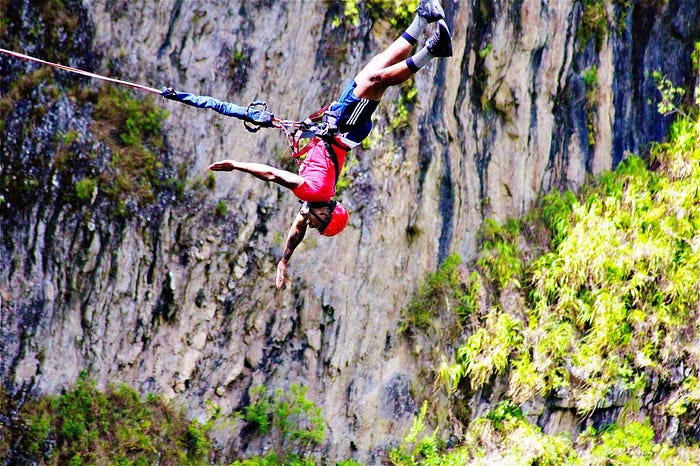Travel & Blood Clots: Staying Alive While Living
Every March, I fly to Charlottesville, Virginia to see my hematologist in the Emily Couric Cancer Center because she wants to make sure I’m fine and I wanna make sure I won’t die in a Spanish Gothic Quarter with fartons in my hand.
Again. Because I tell her everything that’s happening in my life — at least everything worth telling — her first question is always about some ridiculous thing she knows I’d do between seeing her. Her latest question: “Are you still diving off cliffs in the middle of the ocean?” “Not this year. Not yet,” I say slyly, knowing I have a few trips lined up. Then we begin the examination.

It was September 2004 and me, Dennis, and Eddie were at a downtown Daytona Beach club, drinking whatever was cheap, and listening to that squeaky box spring intro on “Some Cut” by Trillville, eyeing the room to see who we’d creep up on with some college boy club grinding motion. Strobe lights were bouncing off the mirror in the not-so-dark club, hiked skirts were being shifted down, hands were mixing with the liquors and dollars spilled on the floor, and everyone’s guard was down, vibing with the music.
“On my mama!” one man screamed out, much louder than the song. Without thought, everyone scattered. We knew what always came after that southern war cry. We found out weeks later that bullets hit the ceiling, a few columns and the walls. I made it as far at the curb just outside the entrance before I could no longer breathe. “Y’all keep running,” I told Eddie and Dennis. “Save yourself!” “I’m so out of shape” I said to myself. They’re my brothers, so of course they stayed with me until I could breathe and we walked swiftly to the car. No one died that night.
I flew home to Woodbridge two days later. Walking through the airport, I had to stop several times, cursing my lack of cardio in the past. I was simply out of breath and energy. My son was due in 6 weeks and his mother and I lived on the third floor with no elevator. I could barely make it up the stairs. Two weeks passed and one day, in the shower, I couldn’t breathe and thought I was having a panic attack. I stepped out and laid on the floor, naked, thinking it was the end. The things we think about when we think we’re dying are ridiculous. “Who’s gonna find me naked?” “Is my family gonna let me girlfriend ride in the front limo?” “Did I eat enough good food over the course of my life?” “Please don’t let me mama play too much gospel at the funeral.” I survived.
The following day I woke up unable to walk because of the damning pain in my groin and blamed it on a possible muscle pull from running during the gunfire. I know how foolish a thought that was since the shooting was a long while back. Shauna, the big-bellied woman laying next to me, told me I’d have to go to the doctor the next day if it was worse. I woke up, put my feet on the floor and collapsed. The pain was unbelievable. Cameron picked us up and 45 minutes later, I was laying on a table.

After telling the doctor why I believed I pulled a groin, she nodded slowly, rolled her eyes a little, and said, “Well, we’ll see soon.” She patted my hand as if to say, “this is definitely not a groin pull,” and left me on that cheap gurney. Always one for jokes, I kept the mood light, and made Shauna promise not to call my very motherly mother, who I knew would jump in the car and make the two-hour drive to Woodbridge.
The doctor was back a few minutes later with a half-cocked smile and right-tilted head — the kind that’s always tilted to provide an extra cushion for bad news or comfort. She asked, “how long have you been short of breath?” I told her it had been a couple weeks, but it only happened when I was “doing too much.” She said, “You probably should have been dead weeks ago. You have three clots in your lungs and 13 in your leg, from your ankle to your groin.” Shauna called my mom. Cameron, in true fashion, said “damn,” and I sat there, waiting to find out what it all meant.

The eight days I spent in the hospital were hard. I was told I couldn’t move my leg, so I pretended it wasn’t even there. Even when the nurses completely forgot about me and didn’t change my sheets or IV when they should have, I stayed completely still. I woke up the day after my release with my leg stuck in a bent, flamingo-like position, and a pain I would only wish on racists.
After weeks of back and forths with a medical team who didn’t put patients first and who refused to give me pain meds that actually worked (which I loudly blamed on them not believing Black people felt pain like others), my mom picked me up and drove me to UVA Medical Center where I was given a box of fentanyl patches that felt like heaven when combined with a completely hot bath. “Put the patch on, and try to straighten your leg,” the doctor told me.
November 22, 2004, I woke up determined to push myself to the limits. I did and my leg was straight…ish. I was at least able to hop down the stairs, walk with a limp around the stores, to the mailbox, and all through the house.
Around midnight, I walked into the bathroom and found Shauna on the floor, in labor. I called Cameron again. My son was born just a few hours later. I still tell the story about Cameron pushing both of us into the hospital in wheelchairs.

That was the beginning of my blood clot journey due to a protein S deficiency.
I’ve gone through the medications and to the appointments. I hated so much of it, especially having to go in weekly for almost a year to make sure my blood was as thin as it needed to be. Dietary restrictions for a foodie like me are murder. What killed me most was when the doctor told me I wouldn’t be able to travel as much as I wanted because sitting for long periods of time in a cramped space can absolutely cause clotting. “The longer the flight, the more at risk you become.” I remember sitting in a doctor’s office just days before a trip to Hong Kong and listening to him say, “if you get on that plane, you will die.” Like Rachel Green, I canceled my flight.
Traveling, exploring, adventuring, truly living are true passions of mine and the universe decided to throw a wrench. I caught it. It was 2012. I sat my doctors down and demanded that they help me find a way to live the life I want. They were hesitant in the beginning, saying things like, “I think you just have to do less of a lot.” After our apparent standoff, which consisted of me being foolishly defiant, they agreed we could exhaust the possibilities in finding what would work.

I’ve taken almost all the pills someone with my condition would take — Coumadin, Eliquis, Lovenox, Pradaxa, and during the hospital stays, Heparin. Some worked better than others, and one not at all. Mostly, they kept me alive, but they each came with things I didn’t want, such as frequent doctor visits, restrictions that would be impossible for me to adhere to.
After Eliquis gave me my first experience with anxiety and had me hiding under the covers at home until it wore off, I called the doctor and told them I could no longer take them. I developed a pulmonary embolism in Guatemala because I chose death over an anxiety attack, and when I returned to the states, I booked a flight to get to the Charlottesville to have a thorough check — absolutely knowing I shouldn’t be on a plane with a possible clot, but I needed to see the medical team I trusted most and my mama. I arrived unable to walk with a straight gait, and they found 16 clots, some new, some old, and some sketchy. This was 2016 and maybe the 15th time I’d been hospitalized for a clot. This was the first time they suggested surgery. The pain said “yes.”
I moved to South Africa shortly after surgery, against every doctor’s wish. “How will we monitor you,” they asked. “Do you know any doctors over there?” The only ease I could offer was promising to never miss an appointment, and I didn’t. “You’re young, you’re active, and you’re pretty healthy, other than these clots. There’s a medicine I think will work great for you,” my nurse practitioner said. And with that, they sent me on my way with Xarelto, the same medicine Chris Bosh, Arnold Palmer, and Brian Vickers take. There’s my claim to fame.

And here we are in 2021 with once-a-year visits and random phone calls in between, a dope collection of compression socks thanks to friends who know both the struggle and my love for conversation-starting socks, and hundreds of thousands of air miles at my disposal. My relationship with my health team is great, and we’re at the point where we can laugh when I answer her “what have you been doing” with “chasing cheese down hills in Gloucestershire.”

We found a way to keep me alive while I’m living. There’s so much more to do, see, taste, and experience. The Inca Trail waits for me like a German Shepherd for his best friend. There’s a cliff in Amoudi Bay, Greece I haven’t yet climbed, and there are the waters just below into which I haven’t jumped. So yeah, there’s so much living to do.
Funny enough, I sat out to write a few tips on how to keep your blood and legs and body in a good space while traveling, and it turned into a story I haven’t shared often and possibly even an ad for Xarelto.

Since you’re here, here are a few tips to keep your blood flowing while traveling:
1. Get you an amazing collection of compression socks and compression tights even. The basketball players are always in what looks like compression tights and I’ve been trying to convince myself to buy a pair. One day soon!
2. When flying, get up every 1–2 hours and walk the aisles to get your blood flowing. Stretch your legs a bit.
3. Elevate your legs when you reach your destination and while you sleep. I put mine on the wall.
4. If you’re at risk for blood clots, talk to your doctor prior to traveling.
These factors increase the risk:
a. Varicose veins
b. Pregnancy and the postpartum period
c. Hormone Replacement Therapy
d. Obesity
e. Age 40+
f. Use of contraceptives containing estrogen
g. Active cancer and recent cancer treatment
Stay healthy, my friends. Keep living!
